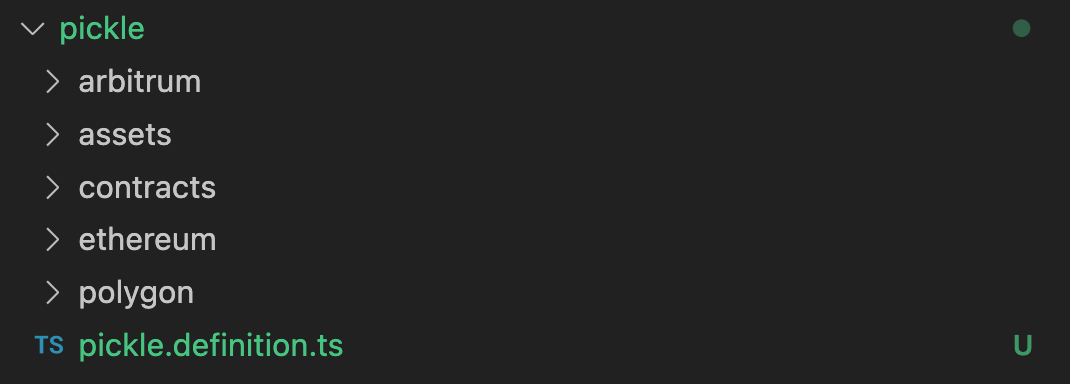Update your app definition
In this section, we'll inspect and build upon the generated App Definition.
Inspect the generated code
After following the previous section, you should now have a skeleton folder structure for our Pickle Finance application integration.

The app definition file created in src/apps/pickle/pickle.definition.ts will be our starting point. Let's have a look!
import { Register } from '~app-toolkit/decorators';
import { AppDefinition } from '~app/app.definition';
import { ProtocolAction } from '~app/app.interface';
import { Network } from '~types/network.interface';
export const PICKLE_DEFINITION = {
id: 'pickle',
name: 'Pickle Finance',
description:
'Pickle Finance helps users to maximize their DeFi yields by auto-compounding their rewards, saving them time and gas.',
url: 'https://pickle.finance/',
groups: {},
tags: [],
supportedNetworks: {
[Network.ETHEREUM_MAINNET]: [ProtocolAction.VIEW],
[Network.POLYGON_MAINNET]: [ProtocolAction.VIEW],
[Network.ARBITRUM_MAINNET]: [ProtocolAction.VIEW],
},
primaryColor: '#fff',
};
@Register.AppDefinition(PICKLE_DEFINITION.id)
export class PickleAppDefinition extends AppDefinition {
constructor() {
super(PICKLE_DEFINITION);
}
}
export default PICKLE_DEFINITION;
The prompts in the previous step have filled in most of the details of our application, including the ID, name, description, and URL. We see that the networks that we intend to support have also been populated.
You'll notice that a class has been declared called PickleAppDefinition, and it has been decorated with @Register.AppDefinition. This annotation registers this the Pickle app definition as a provider in our NestJS app so it can be discovered by the rest of the application.
What are groups?
In Zapper, we define a group as a discrete type of investment opportunity. We distinguish two types of groups: tokenized groups and non-tokenized groups. Elements of a tokenized group are simply referred to as Tokens, and elements of a non-tokenized group are referred to as Contract Positions. Let's take a look at a few examples!
Tokens
Tokens are investment positions that are represented by a token standard like ERC20. These are transferrable and fungible positions that maybe considered as a receipt for an investment transaction. These receipts may be used to represent:
- Liquidity pool positions in a decentralized exchange like Uniswap, SushiSwap, or Curve
- Autocompounding "vaults" like in a yield aggregator like Pickle or Yearn
- Supply and borrow positions in a lending app like Aave
- Or even more obscure primitives like options in Opyn or prize savings accounts in PoolTogether
Contract Positions
Contract Positions are investment positions that are not represented by a token standard. It is often these positions that are more difficult to track by simple wallet applications, and this is especially where Zapper shines, decoding these positions from blockchain data and showing it to the user in a straightforward manner in their portfolio. These positions may be used to represent:
- Farming pool token positions in SushiSwap Master Chef staking contracts
- Bonds in Olympus or other apps that aim to own their liquidity
- Leveraged positions in isolated markets like Abracadabra cauldrons or Alchemix alchemists
- Claimable airdrops across the Web3 ecosystem!
As a little rule of thumb, you likely won't be able to manually add these positions to your Metamask wallet because they are not tokenized! For example, once you deposit a token into a SushiSwap Master Chef farm, your wallet will likely not be able to display this position.
Add groups to your app
In this guide, we will integrate Pickle Jars and Farms.
Jar deposits are represented by an ERC20 token that wraps the underlying token being deposited. Farms, however, are not represented by a token.
Our CLI allows us to quickly add groups to an existing app. Run yarn studio create-group pickle, and follow the prompts. For Jar tokens, we'll configure the ID to jar, the label to Jars, and the type to token. For farms, we'll configure the ID to farm, the label to Farms, and the type to contract-position.
You will see the groups entry in our app definition updated to express these positions.
// Import the GroupType in order to leverage it in our definition
import { GroupType } from '~app/app.interface';
//...
export const PICKLE_DEFINITION = {
// ...
groups: {
jar: {
id: 'jar',
type: GroupType.TOKEN,
label: 'Jars',
},
farm: {
id: 'farm',
type: GroupType.POSITION,
label: 'Farms',
},
},
// ...
};
(NB: In reality, Pickle has a few more group types. Don't be alarmed! Apps evolve over time and we'll need to update their integrations as they do so)
Voila! Our definition file is now more complete, and we can start defining our position fetchers.